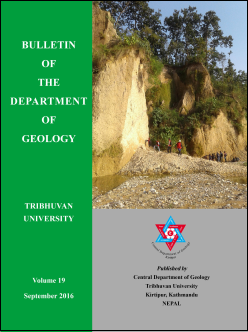Dry season discharge and sediment yield of the northern tributaries of the Kathmandu Valley, Central Nepal
DOI:
https://doi.org/10.3126/bdg.v19i0.19988Keywords:
Stream discharge, Boundary shear stress, Critical shear stress, Sediment yield, Stream power, Bagmati RiverAbstract
Population growth, urbanization and improper land use practice cause change in natural behavior of the river system. In this point soil erosion and sediment deposition in the river channel adversely bring environmental problems like variation in discharge, surface water physical quality, sediment transportation capacity, sediment yield and stream power. In lack of proper research and planning, disasters like flooding, failure of engineering structure, bank erosion and imbalance in aquatic ecosystem can be seen. To better understand the stream, present work was carried out to determine the discharge, sediment transportation capacity, sediments yield and stream power of northern major tributaries of the Bagmati River. Subsequent to this, relations between the two or more than two morpho-hydraulic parameters with the discharge and sediments load were evaluated.
The northern Bagmati River basin occupies an area of 3750 sq. km and lies within 26°42’ and 27°50’ N latitude and 85°02’ and 85°58’ E longitude. The Bagmati River, non-glacial perennial river, consists of four main tributaries contributing from the northern part of the Bagmari River basin. They are the Manahara River, Bagmati River, Dhobi Khola and the Bishnumati River. The four major tributaries including the Bagmati River were upto sixth stream order. The study revealed that water discharge varied from 0.033 to 1.983 m3/s and the grain size distribution d50 ranged from 0.0002 to 0.0250 m. The study found that the suspended load for dry season varied from 5.93 to 916 mg/L and the bed load from 6 to 393711 tonnes/day. The total sediment yield ranged from 0.58 to 22029.64 tonnes/km2/day. The boundary shear stress and critical shear stress ranged from 0.03 to 30.87 N/m2 and 0.05 to 0.06 N/m2, respectively. The stream power per unit channel width was found to vary from 0.001 to 0.06 KNm/s/m2 for tributaries. Except at few sites, the rest of the sites of the studied river exhibit competency and good capability of sediment transport of the rivers. This study helps to implement proper engineering hydraulic practices around the river corridors.
Bulletin of the Department of Geology, Vol. 19, 2016, pp. 29–44
Downloads
Downloads
Published
How to Cite
Issue
Section
License
© Central Department of Geology, Tribhuvan University, Nepal

